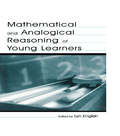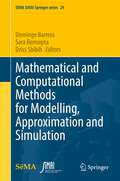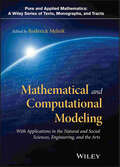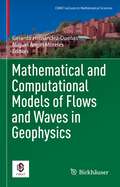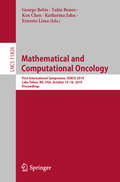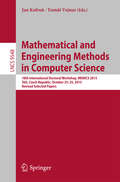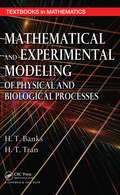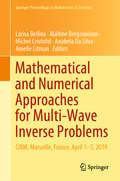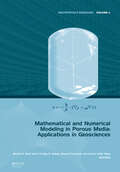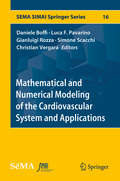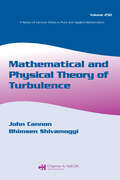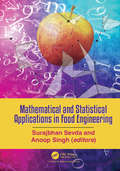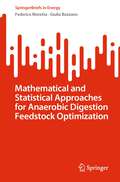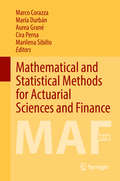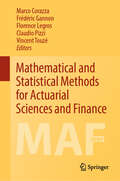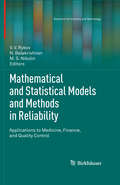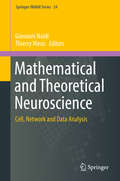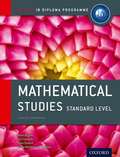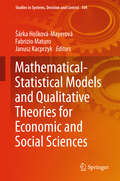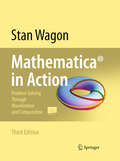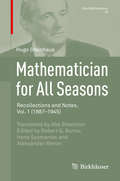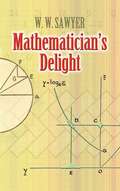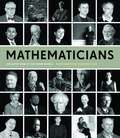- Table View
- List View
Mathematical and Algorithmic Foundations of the Internet (Chapman & Hall/CRC Applied Algorithms and Data Structures series)
by Fabrizio Luccio Linda Pagli Graham SteelTo truly understand how the Internet and Web are organized and function requires knowledge of mathematics and computation theory. Mathematical and Algorithmic Foundations of the Internet introduces the concepts and methods upon which computer networks rely and explores their applications to the Internet and Web. The book offers a unique approach to
Mathematical and Analogical Reasoning of Young Learners (Studies in Mathematical Thinking and Learning Series)
by Lyn D. EnglishMathematical and Analogical Reasoning of Young Learners provides foundational knowledge of the nature, development, and assessment of mathematical and analogical reasoning in young children. Reasoning is fundamental to understanding mathematics and is identified as one of the 10 key standards for school mathematics for the new millennium. The book draws on longitudinal and cross-cultural studies, conducted in the United States and Australia, of children's reasoning development as they progressed from preschool through the end of second grade. The multifaceted analysis of young children's development of mathematical and analogical reasoning focuses on individual learners, their learning environments, and the interaction between the two. The multidisciplinary team of authors present multiple perspectives and multiple methodologies, and provide valuable information on organizing and sustaining interdisciplinary and cross-cultural inquiry. Key issues addressed include: *the relationship between mathematical and analogical reasoning; *how changes in children's reasoning relate to the implicit instruction they receive in their classrooms; *analyses of the participating teachers' knowledge, beliefs, and practices with respect to mathematical and analogical reasoning of young learners; and *ways in which we might promote development of mathematical and analogical reasoning in young children. This volume is highly relevant for mathematics educators, researchers in mathematics education, educational psychologists, early childhood teachers, and others interested in mathematical development of young children, in particular, the development of their reasoning processes.
Mathematical and Computational Methods for Modelling, Approximation and Simulation (SEMA SIMAI Springer Series #29)
by Domingo Barrera Sara Remogna Driss SbibihThis book contains plenary lectures given at the International Conference on Mathematical and Computational Modeling, Approximation and Simulation, dealing with three very different problems: reduction of Runge and Gibbs phenomena, difficulties arising when studying models that depend on the highly nonlinear behaviour of a system of PDEs, and data fitting with truncated hierarchical B-splines for the adaptive reconstruction of industrial models. The book includes nine contributions, mostly related to quasi-interpolation. This is a topic that continues to register a high level of interest, both for those working in the field of approximation theory and for those interested in its use in a practical context. Two chapters address the construction of quasi-interpolants, and three others focus on the use of quasi-interpolation in solving integral equations. The remaining four concern a problem related to the heat diffusion equation, new results on the notion of convexity in probabilistic metric spaces (which are applied to the study of the existence and uniqueness of the solution of a Volterra equation), the use of smoothing splines to address an economic problem and, finally, the analysis of poverty measures, which is a topic of increased interest to society. The book is addressed to researchers interested in Applied Mathematics, with particular reference to the aforementioned topics.
Mathematical and Computational Modeling
by Roderick MelnikIllustrates the application of mathematical and computational modeling in a variety of disciplines With an emphasis on the interdisciplinary nature of mathematical and computational modeling, Mathematical and Computational Modeling: With Applications in the Natural and Social Sciences, Engineering, and the Arts features chapters written by well-known, international experts in these fields and presents readers with a host of state-of-the-art achievements in the development of mathematical modeling and computational experiment methodology. The book is a valuable guide to the methods, ideas, and tools of applied and computational mathematics as they apply to other disciplines such as the natural and social sciences, engineering, and technology. Mathematical and Computational Modeling: With Applications in the Natural and Social Sciences, Engineering, and the Arts also features: Rigorous mathematical procedures and applications as the driving force behind mathematical innovation and discovery Numerous examples from a wide range of disciplines to emphasize the multidisciplinary application and universality of applied mathematics and mathematical modeling Original results on both fundamental theoretical and applied developments in diverse areas of human knowledge Discussions that promote interdisciplinary interactions between mathematicians, scientists, and engineers Mathematical and Computational Modeling: With Applications in the Natural and Social Sciences, Engineering, and the Arts is an ideal resource for professionals in various areas of mathematical and statistical sciences, modeling and simulation, physics, computer science, engineering, biology and chemistry, industrial, and computational engineering. The book also serves as an excellent textbook for graduate courses in mathematical modeling, applied mathematics, numerical methods, operations research, and optimization.
Mathematical and Computational Models of Flows and Waves in Geophysics (CIMAT Lectures in Mathematical Sciences)
by Gerardo Hernández-Dueñas Miguel Angel MorelesThis volume proposes an integral approach to studying the geophysics of Earth. It is motivated by a variety of phenomena from nature with deep and direct impacts in our lives. Such events may evolve across a large range of spatial and time scales and may be observed in the ocean, the atmosphere, the volcanic surface as well as underground.The physical laws dictating the evolution of such phenomena lead to the unifying theme of this manuscript, that is, the mathematical and computational modeling of flows and waves. Consequently, the underlying models are given in terms of Partial Differential Equations (PDEs) whose solutions are approximated using numerical methods, thus providing simulations of the aforementioned phenomena, as well as the appropriate geophysical validation and interpretation.
Mathematical and Computational Oncology: First International Symposium, ISMCO 2019, Lake Tahoe, NV, USA, October 14–16, 2019, Proceedings (Lecture Notes in Computer Science #11826)
by Ken Chen George Bebis Takis Benos Katharina Jahn Ernesto LimaThis book constitutes the refereed proceedings of the First International Symposium on Mathematical and Computational Oncology, ISMCO'2019, held in Lake Tahoe, NV, USA, in October 2019. The 7 full papers presented were carefully reviewed and selected from 30 submissions. The papers are organized in topical sections named: Tumor evolvability and intra-tumor heterogeneity; Imaging and scientific visualization for cancer research; Statistical methods and data mining for cancer research (SMDM); Spatio-temporal tumor modeling and simulation (STTMS).
Mathematical and Engineering Methods in Computer Science
by Jan Kofroň Tomáš VojnarThis volume contains the post-conference proceedings of the 10th Doctoral Workshop on Mathematical and Engineering Methods in Computer Science, MEMICS 2015, held in Telč, Czech Republic, in October 2015. The 10 thoroughly revised full papers were carefully selected out of 25 submissions and are presented together with 3 invited papers. The topics covered include: security and safety, bioinformatics, recommender systems, high-performance and cloud computing, and non-traditional computational models (quantum computing, etc. ).
Mathematical and Experimental Modeling of Physical and Biological Processes (Textbooks in Mathematics)
by H.T. Banks H.T. TranThrough several case study problems from industrial and scientific research laboratory applications, Mathematical and Experimental Modeling of Physical and Biological Processes provides students with a fundamental understanding of how mathematics is applied to problems in science and engineering. For each case study problem, the authors discuss why
Mathematical and Numerical Approaches for Multi-Wave Inverse Problems: CIRM, Marseille, France, April 1–5, 2019 (Springer Proceedings in Mathematics & Statistics #328)
by Larisa Beilina Maïtine Bergounioux Michel Cristofol Anabela Da Silva Amelie LitmanThis proceedings volume gathers peer-reviewed, selected papers presented at the “Mathematical and Numerical Approaches for Multi-Wave Inverse Problems” conference at the Centre Internacional de Rencontres Mathématiques (CIRM) in Marseille, France, in April 2019. It brings the latest research into new, reliable theoretical approaches and numerical techniques for solving nonlinear and inverse problems arising in multi-wave and hybrid systems.Multi-wave inverse problems have a wide range of applications in acoustics, electromagnetics, optics, medical imaging, and geophysics, to name but a few. In turn, it is well known that inverse problems are both nonlinear and ill-posed: two factors that pose major challenges for the development of new numerical methods for solving these problems, which are discussed in detail.These papers will be of interest to all researchers and graduate students working in the fields of nonlinear and inverse problems and its applications.
Mathematical and Numerical Modeling in Porous Media: Applications in Geosciences (Multiphysics Modeling)
by Martín A. Díaz Viera Pratap N. Sahay Theo M. Nieuwenhuizen Manuel Coronado Arturo Ortiz TapiaPorous media are broadly found in nature and their study is of high relevance in our present lives. In geosciences porous media research is fundamental in applications to aquifers, mineral mines, contaminant transport, soil remediation, waste storage, oil recovery and geothermal energy deposits. Despite their importance, there is as yet no complete
Mathematical and Numerical Modeling of the Cardiovascular System and Applications (SEMA SIMAI Springer Series #16)
by Gianluigi Rozza Daniele Boffi Simone Scacchi Luca F. Pavarino Christian VergaraThe book comprises contributions by some of the most respected scientists in the field of mathematical modeling and numerical simulation of the human cardiocirculatory system. It covers a wide range of topics, from the assimilation of clinical data to the development of mathematical and computational models, including with parameters, as well as their efficient numerical solution, and both in-vivo and in-vitro validation. It also considers applications of relevant clinical interest. This book is intended for graduate students and researchers in the field of bioengineering, applied mathematics, computer, computational and data science, and medicine wishing to become involved in the highly fascinating task of modeling the cardiovascular system.
Mathematical and Physical Theory of Turbulence, Volume 250 (Lecture Notes in Pure and Applied Mathematics)
by John Cannon Bhimsen ShivamoggiAlthough the current dynamical system approach offers several important insights into the turbulence problem, issues still remain that present challenges to conventional methodologies and concepts. These challenges call for the advancement and application of new physical concepts, mathematical modeling, and analysis techniques. Bringing together ex
Mathematical and Statistical Applications in Food Engineering
by Anoop Singh Surajbhan SevdaWritten by experts from all over the world, the book comprises the latest applications of mathematical and models in food engineering and fermentation. It provides the fundamentals on statistical methods to solve standard problems associated with food engineering and fermentation technology. Combining theory with a practical, hands-on approach, this book covers key aspects of food engineering. Presenting cuttingedge information, the book is an essential reference on the fundamental concepts associated with food engineering.
Mathematical and Statistical Approaches for Anaerobic Digestion Feedstock Optimization (SpringerBriefs in Energy)
by Federico Moretta Giulia BozzanoThis book examines biomass mixture modeling and optimization. The book discusses anaerobic digestion and related fermentative processes and explains their compositional dynamics. Early chapter examine macromolecules, elemental fractions, and their direct influence on methane production. Supported by an extensive data bank of substrates obtained from research, the book points out correlations that enable the estimation of global methane production for diverse biomass mixtures. Furthermore, it provides valuable insights into discerning the optimal composition capable of yielding the utmost methane output.The book integrates cutting-edge machine learning techniques and shows how the programming language Python and Julia can be used for analysis and to optimize processes. It has many graphs, figures, and visuals.
Mathematical and Statistical Methods for Actuarial Sciences and Finance: MAF 2018
by Cira Perna Marilena Sibillo Marco Corazza María Durbán Aurea GranéThe interaction between mathematicians, statisticians and econometricians working in actuarial sciences and finance is producing numerous meaningful scientific results. This volume introduces new ideas, in the form of four-page papers, presented at the international conference Mathematical and Statistical Methods for Actuarial Sciences and Finance (MAF), held at Universidad Carlos III de Madrid (Spain), 4th-6th April 2018. The book covers a wide variety of subjects in actuarial science and financial fields, all discussed in the context of the cooperation between the three quantitative approaches. The topics include: actuarial models; analysis of high frequency financial data; behavioural finance; carbon and green finance; credit risk methods and models; dynamic optimization in finance; financial econometrics; forecasting of dynamical actuarial and financial phenomena; fund performance evaluation; insurance portfolio risk analysis; interest rate models; longevity risk; machine learning and soft-computing in finance; management in insurance business; models and methods for financial time series analysis, models for financial derivatives; multivariate techniques for financial markets analysis; optimization in insurance; pricing; probability in actuarial sciences, insurance and finance; real world finance; risk management; solvency analysis; sovereign risk; static and dynamic portfolio selection and management; trading systems. This book is a valuable resource for academics, PhD students, practitioners, professionals and researchers, and is also of interest to other readers with quantitative background knowledge.
Mathematical and Statistical Methods for Actuarial Sciences and Finance: MAF2024
by Claudio Pizzi Marco Corazza Florence Legros Frédéric Gannon Vincent TouzéThe book presents a collection of peer-reviewed short papers selected from those presented at the International Conference Mathematical and Statistical Methods for Actuarial Sciences and Finance – MAF2024. The year 2024 marks the twentieth anniversary of the first edition of this conference. The idea behind this book is that collaboration and cross-pollination between mathematicians and statisticians working in actuarial sciences and finance could enhance research in these fields. The effectiveness of this concept has been demonstrated by widespread participation across all editions, held at various locations including the University of Salerno, Italy (2004, 2006, 2010, 2014, and 2022); Ca' Foscari University of Venice, Italy (2008, 2012, and 2020); University Paris-Dauphine in Paris, France (2016); University Carlos III of Madrid, Madrid (2018); and University of Le Havre Normandie, Le Havre, France (2024). This effectiveness is also evident in the attention consistently shown by both the scientific community and professionals toward the volumes of peer-reviewed papers accompanying all past editions of MAF. The book is a valuable resource for academics, researchers, Ph.D. students, and professionals. Furthermore, it is also of interest to other readers with a quantitative background.
Mathematical and Statistical Models and Methods in Reliability
by N. Balakrishnan M. S. Nikulin V. V. RykovThe book is a selection of invited chapters, all of which deal with various aspects of mathematical and statistical models and methods in reliability. Written by renowned experts in the field of reliability, the contributions cover a wide range of applications, reflecting recent developments in areas such as survival analysis, aging, lifetime data analysis, artificial intelligence, medicine, carcinogenesis studies, nuclear power, financial modeling, aircraft engineering, quality control, and transportation. Mathematical and Statistical Models and Methods in Reliability is an excellent reference text for researchers and practitioners in applied probability and statistics, industrial statistics, engineering, medicine, finance, transportation, the oil and gas industry, and artificial intelligence.
Mathematical and Statistical Skills in the Biopharmaceutical Industry: A Pragmatic Approach (Chapman & Hall/CRC Biostatistics Series)
by Arkadiy PitmanMathematical and Statistical Skills in the Biopharmaceutical Industry: A Pragmatic Approach describes a philosophy of efficient problem solving showcased using examples pertinent to the biostatistics function in clinical drug development. It was written to share a quintessence of the authors’ experiences acquired during many years of relevant work in the biopharmaceutical industry. The book will be useful will be useful for biopharmaceutical industry statisticians at different seniority levels and for graduate students who consider a biostatistics-related career in this industry. Features: Describes a system of principles for pragmatic problem solving in clinical drug development. Discusses differences in the work of a biostatistician in small pharma and big pharma. Explains the importance/relevance of statistical programming and data management for biostatistics and necessity for integration on various levels. Describes some useful statistical background that can be capitalized upon in the drug development enterprise. Explains some hot topics and current trends in biostatistics in simple, non-technical terms. Discusses incompleteness of any system of standard operating procedures, rules and regulations. Provides a classification of scoring systems and proposes a novel approach for evaluation of the safety outcome for a completed randomized clinical trial. Presents applications of the problem solving philosophy in a highly problematic transfusion field where many investigational compounds have failed. Discusses realistic planning of open-ended projects.
Mathematical and Theoretical Neuroscience: Cell, Network And Data Analysis (Springer INdAM #24)
by Giovanni Naldi Thierry NieusThis volume gathers contributions from theoretical, experimental and computational researchers who are working on various topics in theoretical/computational/mathematical neuroscience. The focus is on mathematical modeling, analytical and numerical topics, and statistical analysis in neuroscience with applications. The following subjects are considered: mathematical modelling in Neuroscience, analytical and numerical topics; statistical analysis in Neuroscience; Neural Networks; Theoretical Neuroscience. The book is addressed to researchers involved in mathematical models applied to neuroscience.
Mathematical studies Standard Level: Course Companion (Oxford IB Diploma Programme)
by Jane Forrest Peter Blythe Jim Fensom Paula Waldman de TokmanNumber and algebra 1, Descriptive statistics, Geometry and trigonometry 1, Mathematical models, Statistical applications, Introducing differential calculus, Number and algebra 2, Sets and probability, Logic, Geometry and trigonometry 2, Project, Getting the most out of your GDC, Prior learning.
Mathematical-Statistical Models and Qualitative Theories for Economic and Social Sciences
by Janusz Kacprzyk Šárka Hošková-Mayerová Fabrizio MaturoThis book presents a broad spectrum of problems related to statistics, mathematics, teaching, social science, and economics as well as a range of tools and techniques that can be used to solve these problems. It is the result of a scientific collaboration between experts in the field of economic and social systems from the University of Defence in Brno (Czech Republic), G. d'Annunzio University of Chieti-Pescara (Italy), Pablo de Olavid eUniversity of Sevilla (Spain), and Ovidius University in Constanţa, (Romania). The studies included were selected using a peer-review process and reflect heterogeneity and complexity of economic and social phenomena. They and present interesting empirical research from around the globe and from several research fields, such as statistics, decision making, mathematics, complexity, psychology, sociology and economics. The volume is divided into two parts. The first part, "Recent trends in mathematical and statistical models for economic and social sciences", collects papers on quantitative matters, which propose mathematical and statistical models for social sciences, economics, finance, and business administration. The second part, "Recent trends in qualitative theories for economic and social sciences", includes papers on qualitative matters, which discuss social, economic, and teaching issues. It is an ideal reference work for all those researchers interested in recent quantitative and qualitative tools. Covering a wide range of topics, it appeals in equal measure to mathematicians, statisticians, sociologists, philosophers, and specialists in the fields of communication, social and political sciences.
Mathematica® in Action
by Stan WagonPlenty of examples and case studies utilize Mathematica 7's newest tools, such as dynamic manipulations and adaptive three-dimensional plotting. Emphasizes the breadth of Mathematica and the impressive results of combining techniques from different areas. Whenever possible, the book shows how Mathematica can be used to discover new things. Striking examples include the design of a road on which a square wheel bike can ride, the design of a drill that can drill square holes, and new and surprising formulas for p. Visualization is emphasized throughout, with finely crafted graphics in each chapter.
Mathematician for All Seasons
by Hugo SteinhausRobert G. Burns Irena Szymaniec Aleksander WeronThis book presents, in his own words, the life of Hugo Steinhaus (1887-1972), noted Polish mathematician of Jewish background, educator, and mathematical popularizer. A student of Hilbert, a pioneer of the foundations of probability and game theory, and a contributor to the development of functional analysis, he was one of those instrumental to the extraordinary flowering of Polish mathematics before and after World War I. In particular, it was he who "discovered" the great Stefan Banach. Exhibiting his great integrity and wit, Steinhaus's personal story of the turbulent times he survived - including two world wars and life postwar under the Soviet heel - cannot but be of consuming interest. His recounting of the fearful years spent evading Nazi terror is especially moving. The steadfast honesty and natural dignity he maintained while pursuing a life of demanding scientific and intellectual enquiry in the face of encroaching calamity and chaos show him to be truly a mathematician for all seasons. The present work will be of great interest not only to mathematicians wanting to learn some of the details of the mathematical blossoming that occurred in Poland in the first half of the 20th century, but also to anyone wishing to read a first-hand account of the history of those unquiet times in Europe - and indeed world-wide - by someone of uncommon intelligence and forthrightness situated near an eye of the storm.
Mathematician's Delight
by W. W. Sawyer"Recommended with confidence" by The Times Literary Supplement, this lively survey starts with simple arithmetic and algebra and proceeds by gradual steps through graphs, logarithms, and trigonometry to calculus and the world of numbers. Generations of readers have found it the ideal introduction to mathematics, offering accessible explanations of how theory arises from real-life applications."The main object of this book is to dispel the fear of mathematics," declares author W. W. Sawyer, adding that "Many people regard mathematicians as a race apart, possessed of almost supernatural powers. While this is very flattering for successful mathematicians, it is very bad for those who, for one reason or another, are attempting to learn the subject." Now retired, Sawyer won international renown for his innovative teaching methods, which he used at colleges in England and Scotland as well as Africa, New Zealand, and North America. His insights into the pleasures and practicalities of mathematics will appeal to readers of all backgrounds.
Mathematicians
by Robert C. Gunning Mariana CookMathematicians is a remarkable collection of ninety-two photographic portraits, featuring some of the most amazing mathematicians of our time. Acclaimed photographer Mariana Cook captures the exuberant and colorful personalities of these brilliant thinkers and the superb images are accompanied by brief autobiographical texts written by each mathematician. Together, the photographs and words illuminate a diverse group of men and women dedicated to the absorbing pursuit of mathematics. The compelling black-and-white portraits introduce readers to mathematicians who are young and old, fathers and daughters, and husbands and wives. They include Fields Medal winners, those at the beginning of major careers, and those who are long-established celebrities in the discipline. Their candid personal essays reveal unique and wide-ranging thoughts, opinions, and humor, as the mathematicians discuss how they became interested in mathematics, why they love the subject, how they remain motivated in the face of mathematical challenges, and how their greatest contributions have paved new directions for future generations. Mathematicians in the book include David Blackwell, Henri Cartan, John Conway, Pierre Deligne, Timothy Gowers, Frances Kirwan, Peter Lax, William Massey, John Milnor, Cathleen Morawetz, John Nash, Karen Uhlenbeck, and many others. Conveying the beauty and joy of mathematics to those both within and outside the field, this photographic collection is an inspirational tribute to mathematicians everywhere.

